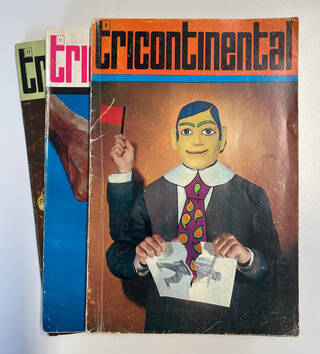In the glow of the 1959 Cuban Revolution, artists and designers in Cuba sparked change through bold poster design.
The V&A has in its collections about 200 posters produced by OSPAAAL, which stands for the 'Organization of Solidarity with the People of Asia, Africa and Latin America'.
The abbreviation comes from the group's name in Spanish: 'Organización de Solidaridad de los Pueblos de Asia, África y América Latina'. OSPAAAL was an international non-governmental organisation founded in 1966, which sought to hold dialogue with and reach activists across the globe.
With representation from over 80 countries in the Global South, the Tricontinental Conference, held in Havana, Cuba in 1966, was a defining moment for the creation of OSPAAAL. The conference was an important milestone in transnational political solidarity, championing the liberation struggles across continents and condemning imperialism and colonialism.
Distribution and technique
OSPAAAL was most active during the 1960s to the 1980s (as tensions spread due to the ongoing Cold War), and quickly became a hub for revolutionary ideas. Its main communication tool was the Tricontinental magazine, which gave a platform for acts of resistance against colonial rule. In 1989, the magazine recorded its highest distribution figures, with a circulation of 30,000 reaching 87 countries. The magazine included colourful posters folded within its pages that could easily be removed and put on show. Artist Jane Norling recalls seeing the posters in California the 1970s: "When I arrived in San Francisco, started meeting people and being educated about U.S. imperialism, I saw these posters all over their walls".

The first poster to be distributed with the magazine was Alfrédo Rostgaard's Create, two, three...many Vietnams (1967). Here, OSPAAAL's long-standing art director deployed a 'mosaic' or repetition method to make best use of the limited materials to hand in Cuba at the time. Later, when reflecting on his work for the campaigning organisation, Rostgaard remarked: "We wanted to establish a clear, direct or indirect, but original communication, and did not scorn any initiative that would allow us to be effective and contemporary". OSPAAAL posters achieved these aims through an originality of tone and the propagation of ideas despite limits on resources during the Cold War.
Reach
Key to OSPAAAL's mission were ideas of physical and emotional solidarity: emotional solidarity through the exchange of ideas and posters via the Tricontinental magazine, and physical solidarity in places like Angola, where Cuban soldiers were sent to help in the Angolan War of Independence (1961 – 74).
Posters typically feature translations in four of the UN-recognised official languages: English, French, Arabic and Spanish. From Laos to Guatemala, Guinea Bissau to Vietnam, the poster's subjects vary enormously, though all are united in their message encouraging viewers to take a day or week in solidarity. The poster Angola by Daysi García exemplifies these elements, with four different language translations of '4th of February' – a day of solidarity marking the beginning of the Angolan War of Independence.
Although most of the posters were designed and produced in Cuba, OSPAAAL's reach included all three of the continents reflected in its name, as well as over 20 countries and movements they decided to support.
Designers
A mix of graphic designers and artists worked for OSPAAAL over the years, contributing to the over 300 poster designs produced between 1967 and 2019. Many also worked in other artistic fields. Artists such as René Mederos, Alfrédo Rostgaard, René Portocarrero and Raúl Martínez contributed to the creation of Cuban film posters, as well as becoming prominent in the pop art and abstract art scenes. Eight women designers are known to have worked for the group over the years, including Elena Serrano whose 1968 Day of the Heroic Guerilla op art poster alludes to Che Guevara's popularity and dreams of liberation spreading across the world.
International collaboration and inspiration
Despite the tumultuous US-Cuba relations during this era, the posters show that artists were still well informed about issues happening outside their country, and actively sharing materials and ideas. In the poster Solidarity with the African American People, 18 August, the designer Lázaro Abreu uses an illustration by Emory Douglas, the American graphic artist known for his Black Panther Party graphics, as the main image. Emory Douglas speaks of being "glad to see [his work] picked up", despite never having visited Cuba himself and recalls being inspired by seeing Cuban graphics on material that had been sent to Eldridge Cleaver, an early leader of the Black Panther Party.
Printing methods
The vast majority of OSPAAAL posters were printed using an offset lithograph technique, which allows for mass printing by repeating a process of layering colours and dots to create a final image. Though less prevalent in the OSPAAAL workshop, silkscreen printing was also used, whereby ink passes colour, screen by screen, through a mesh. An example of the silkscreen technique can be seen in Antonio Mariño's poster Day of Solidarity with Guatemala, 6 February.
OSPAAAL wound down the production of posters during the 1990s, and though some were still produced after this time, they tended to be one-off collaborations, for example Barak Obama by Dr. Alderete (published in El Fanzine, 2013), which is illustrated in the style of Alfrédo J. Gonzalez Rostgaard's poster Nixon.
The Havana-based offices for the group officially shut in 2019, following 53 years of advocating for solidarity and unity amongst countries in the Global South. The OSPAAAL offices, based in the historic Vedado neighbourhood in Havana, had included a research room, materials repository and a historical archive. The legacy of the group lives on through the individuals and interest groups, such as the Tricontinental: Institute for Social Research, ensuring that its solidarity and design contributions continue to be recognised for years to come.










